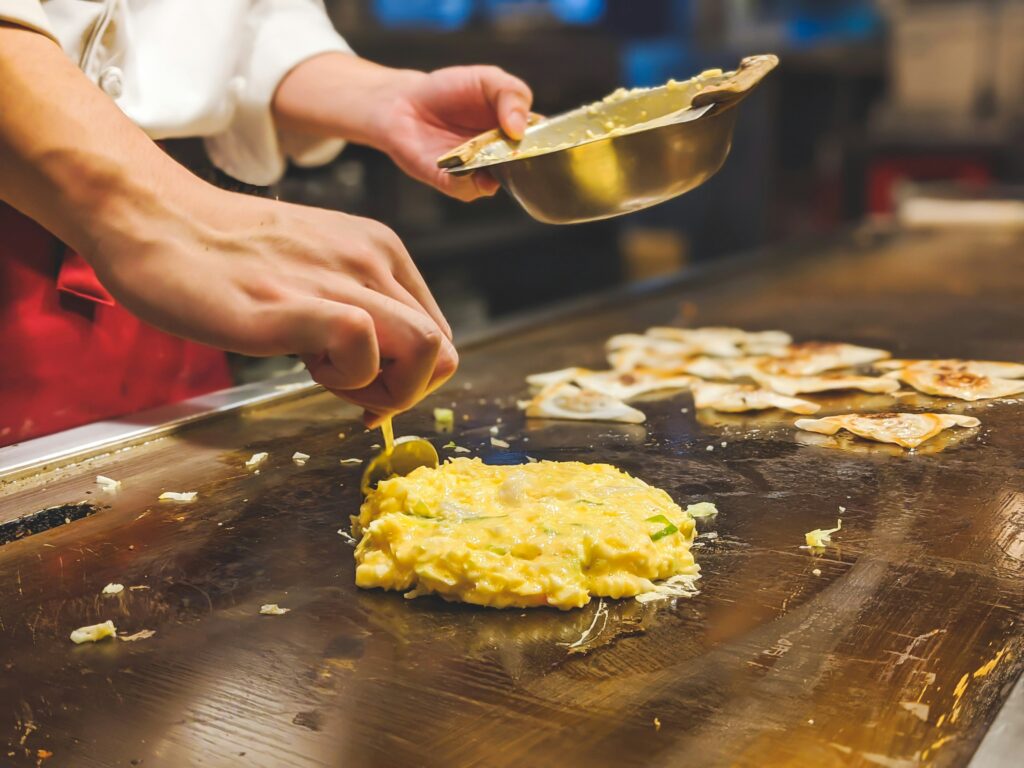
Okonomiyaki: The Ultimate Guide to Japan’s Savory Pancake
If you’ve ever traveled to Japan or ventured into authentic Japanese restaurants abroad, you might have encountered okonomiyaki (お好み焼き) – a savory pancake that perfectly embodies the creative, customizable nature of Japanese comfort food. Unlike the sweet breakfast pancakes familiar to Americans, okonomiyaki is a hearty, savory dish that’s as fun to make as it is delicious to eat.
The name okonomiyaki literally translates to “grilled as you like it” (okonomi meaning “what you like” and yaki meaning “grilled” or “cooked”). True to its name, this versatile dish invites endless customization, making it both a beloved home-cooked meal and a popular restaurant offering throughout Japan.
What Exactly Is Okonomiyaki?
At its most basic, okonomiyaki is a savory pancake made from a batter of flour, grated nagaimo (a type of mountain yam), dashi (Japanese soup stock), eggs, and shredded cabbage. This mixture is then topped with various ingredients before being cooked on a flat iron griddle called a teppan.
Once cooked, it’s typically topped with a sweet-savory okonomiyaki sauce (similar to Worcestershire sauce but thicker and sweeter), Japanese mayonnaise, dried seaweed flakes (aonori), and bonito flakes (katsuobushi). These toppings aren’t just for flavor – they create a dish that engages all the senses, with the paper-thin bonito flakes “dancing” from the heat of the freshly cooked pancake.
The Rich Cultural History of Okonomiyaki
Far more than just a tasty dish, okonomiyaki tells a story of Japanese culinary resilience and regional pride:
From Necessity to Beloved National Dish
The origins of okonomiyaki can be traced back to the early 20th century, but it was during the post-World War II period that it gained widespread popularity. In the aftermath of the war, when rice was scarce, flour-based dishes like okonomiyaki became essential alternatives. Families would mix whatever ingredients they had available into the batter – truly living up to the “as you like it” meaning.
What began as a practical solution to food shortages evolved into a cherished part of Japanese food culture, demonstrating how necessity often gives birth to culinary innovation. Today, okonomiyaki represents the Japanese values of adaptability and making the most of available resources.
Regional Pride and Variation
Like many Japanese dishes, okonomiyaki has developed distinct regional variations that inspire friendly competition and local pride. The two most famous styles come from Osaka and Hiroshima:
| Osaka/Kansai Style | Hiroshima Style |
|---|---|
| All ingredients mixed together in the batter | Ingredients layered rather than mixed |
| Thicker, fluffier texture | Includes yakisoba noodles |
| Flipped once while cooking | More complex cooking technique |
| Most common style found outside Japan | Typically requires specialized tools and skills |
The rivalry between these styles is playful but passionate. Osaka residents will insist their version is the original and best, while Hiroshima natives take pride in the technical skill required for their layered approach. Other regions in Japan have their own variations as well, from Tokyo’s monjayaki (a runnier version) to Fukuoka’s mentaiko (spicy cod roe) specialty.
Okonomiyaki as a Social Experience
Beyond its delicious taste, okonomiyaki offers a uniquely interactive dining experience that reflects important aspects of Japanese food culture:
Teppanyaki-style Communal Cooking
Many okonomiyaki restaurants feature teppan grills built into the tables, allowing diners to cook their own pancakes. This participatory style of dining creates a relaxed, social atmosphere where the preparation becomes part of the entertainment. In Japan, cooking and eating together breaks down formalities and strengthens bonds – whether among family members, friends, or colleagues.
The Art of Shared Food
Unlike the individual portion sizes typical in Western dining, okonomiyaki is often made large enough to share, encouraging conversation and connection. The circular shape itself symbolizes harmony and togetherness in Japanese culture. When everyone at the table contributes to cooking the perfect okonomiyaki, it creates a sense of collective achievement that enhances the dining experience.
Cultural Insight: In Japan, the experience of cooking and eating okonomiyaki together exemplifies the concept of wa (harmony) – a foundational value in Japanese society that emphasizes group cohesion and cooperation over individual preferences.
Popular Okonomiyaki Variations and Ingredients
True to its “as you like it” name, okonomiyaki can include a vast array of ingredients. Here are some of the most popular versions you might encounter:
Classic Protein Options
- Buta-tama (豚玉): Thinly sliced pork belly – the most common version
- Ika-tama (イカ玉): Fresh squid
- Ebi-tama (エビ玉): Shrimp
- Mix-tama (ミックス玉): Combination of seafood and meat
Regional Specialties
- Negiyaki (ねぎ焼き): Osaka specialty with lots of green onions
- Mentaiko (明太子): Spicy cod roe version popular in Fukuoka
- Modan-yaki (モダン焼き): Okonomiyaki with yakisoba noodles (different from Hiroshima-style)
- Kashimin-yaki (カシミン焼き): Featuring oysters, a specialty in oyster-rich regions
Vegetarians can enjoy okonomiyaki too, with options featuring corn, cheese, kimchi, mochi (rice cakes), or simply an abundance of vegetables. The possibilities are truly endless – reflecting the “as you like it” philosophy at the heart of this versatile dish.
Make Your Own Okonomiyaki: Basic Osaka-Style Recipe
Homemade Osaka-Style Okonomiyaki
Ingredients (makes 2 medium pancakes):
- 1 cup all-purpose flour
- 2/3 cup dashi stock (can substitute water or vegetable stock)
- 2 large eggs
- 4 cups finely shredded cabbage (about 1/4 of a medium cabbage)
- 2 green onions, finely chopped
- 1/2 cup tenkasu (tempura scraps) – optional but recommended for authentic texture
- 4 slices thinly-cut pork belly (can substitute bacon or omit for vegetarian version)
- 2 tablespoons vegetable oil for cooking
For toppings:
- Okonomiyaki sauce (can substitute 3 parts Worcestershire sauce, 1 part ketchup, 1 part honey)
- Japanese mayonnaise (Kewpie brand recommended)
- Aonori (dried seaweed flakes)
- Katsuobushi (bonito flakes)
- Pickled ginger (optional)
Instructions:
- In a large bowl, whisk together the flour and dashi stock until smooth. Add the eggs and mix well.
- Fold in the shredded cabbage, green onions, and tenkasu (if using). The batter should be thick and the cabbage should be well-coated but not drowning in batter.
- Heat a large non-stick skillet or griddle over medium heat. Add 1 tablespoon of oil.
- Pour half of the batter into the pan, forming a circle about 7-8 inches (18-20 cm) in diameter and about 3/4 inch (2 cm) thick.
- Lay 2 slices of pork belly on top of the batter.
- Cook for about 5 minutes until the bottom is golden brown and set.
- Carefully flip the okonomiyaki (this is the trickiest part). A good technique is to slide it onto a plate, then invert it back into the pan. Cook for another 5-7 minutes until both sides are golden brown and the pork is cooked through.
- Transfer to a plate and add the toppings: drizzle with okonomiyaki sauce in a zigzag pattern, then do the same with mayonnaise. Sprinkle generously with aonori and katsuobushi.
- Repeat the process with the remaining batter and toppings.
- Serve hot, cutting into wedges with a spatula to eat.
Cooking Tip: Don’t worry if your first attempt isn’t perfect! Okonomiyaki is forgiving by nature. If it falls apart when flipping, simply press it back together with your spatula – it will still taste delicious.
Where to Try Authentic Okonomiyaki in Japan
If you’re planning a trip to Japan, sampling authentic okonomiyaki should definitely be on your culinary bucket list. Here are some regions and establishments known for their outstanding okonomiyaki:
Osaka: The Birthplace of Kansai-Style
Osaka, sometimes called “Japan’s kitchen,” is famous for its street food culture, with okonomiyaki being one of its crowning achievements. The Dotonbori district offers numerous options, from high-end restaurants to casual street-side stalls.
- Chibo: A long-established chain with multiple locations, known for consistent quality
- Mizuno: A family-run shop with lines out the door, famous for their yamaimo-heavy recipe that creates an exceptionally fluffy texture
- Kiji: Located in the Umeda district, beloved by locals for their perfectly balanced sauce
Hiroshima: The Layered Masterpiece
Hiroshima takes great pride in its distinctive style, with an entire area of the city (Okonomimura, or “Okonomiyaki Village”) dedicated to the dish. This food theme park features dozens of okonomiyaki restaurants stacked on multiple floors.
- Okonomimura: Not a single restaurant but a collection of over 20 stalls, each with their own twist on the Hiroshima style
- Hassho: Known for perfectly layered ingredients and generous portions
- Mitchell: A favorite among locals for their special sauce recipe
Tokyo: Modern Interpretations
While Tokyo doesn’t have its own definitive okonomiyaki style (though monjayaki is a Tokyo specialty), the capital city offers excellent renditions of both Osaka and Hiroshima styles, along with innovative takes:
- Kiji Tokyo: An Osaka import that maintains authentic Kansai-style flavor
- Sakuratei in Harajuku: Popular for their all-you-can-eat okonomiyaki experience with unique ingredient options
- Sometaro in Asakusa: A charming old-school establishment with traditional floor seating and cast iron grills
Okonomiyaki’s Place in Japanese Food Culture
To understand okonomiyaki’s significance, it helps to place it in the broader context of Japanese cuisine and cultural values:
Democratic Food in a Hierarchical Society
While Japan is known for highly ritualized and refined cuisines like kaiseki and precisely prepared sushi, okonomiyaki represents the more accessible, democratic side of Japanese food culture. It’s unpretentious food that brings people together regardless of social standing or culinary expertise.
Mottainai: Waste-Not Philosophy
The versatility of okonomiyaki embodies the Japanese concept of mottainai – the cultural aversion to waste. Originally developed to use available ingredients efficiently, okonomiyaki continues to serve as a practical way to transform leftovers into a delicious new meal, reflecting Japan’s resourceful approach to cooking.
Seasonality and Locality
While okonomiyaki can be made year-round with standard ingredients, many Japanese cooks follow the principle of shun (seasonal peak) by incorporating seasonal vegetables or seafood. This reflects the broader Japanese culinary philosophy of celebrating ingredients at their prime.
Bringing Okonomiyaki Into Your Kitchen: Tips for Success
Ready to try making okonomiyaki at home? Here are some practical tips to help you achieve the best results:
Ingredient Sourcing and Substitutions
For authentic flavor, try to source Japanese ingredients from Asian markets or online specialty stores. However, don’t let unavailability stop you – here are some workable substitutions:
- Dashi stock: Can be replaced with vegetable or chicken broth with a dash of soy sauce
- Nagaimo: While traditional for its binding properties, can be omitted if unavailable
- Tenkasu (tempura scraps): Can be replaced with crispy rice cereal or panko breadcrumbs
- Okonomiyaki sauce: The homemade version in our recipe works well, or you can adapt tonkatsu sauce
Equipment Considerations
While specialized equipment is nice, it’s not necessary:
- A good non-stick skillet works perfectly in place of a teppan grill
- If you don’t have the traditional wooden spatulas, wide silicone or metal spatulas work well for flipping
- Squeeze bottles make it easier to apply sauce and mayonnaise artfully, but spoons work too
Make It a Social Event
Embrace the communal spirit of okonomiyaki by making it an interactive dinner party. Set up a DIY okonomiyaki bar with prepared batter and various toppings, allowing everyone to customize their own creation. This not only makes for a fun evening but also stays true to the dish’s “as you like it” philosophy.
Remember that okonomiyaki is meant to be adaptable and fun – there’s no single “correct” way to make it. The best okonomiyaki is the one that brings joy to those who cook and eat it together.
Final Thoughts: Why Okonomiyaki Matters
Okonomiyaki is more than just another Japanese dish – it’s a perfect embodiment of what makes Japanese cuisine special: the balance of flavors and textures, the attention to seasonal ingredients, the communal dining experience, and the adaptation to changing circumstances. It shows how a practical solution to food scarcity evolved into a beloved national treasure that brings people together.
Whether you try it in Japan, at a local Japanese restaurant, or in your own kitchen, okonomiyaki offers a taste of Japanese culture that goes beyond flavor – it’s an experience of creativity, community, and the joy of cooking “as you like it.”
So gather your ingredients, invite some friends, and discover why this savory pancake continues to win hearts and palates around the world. In the process, you’ll gain insight into the values that shape Japanese food culture and perhaps add a new favorite to your own culinary repertoire.
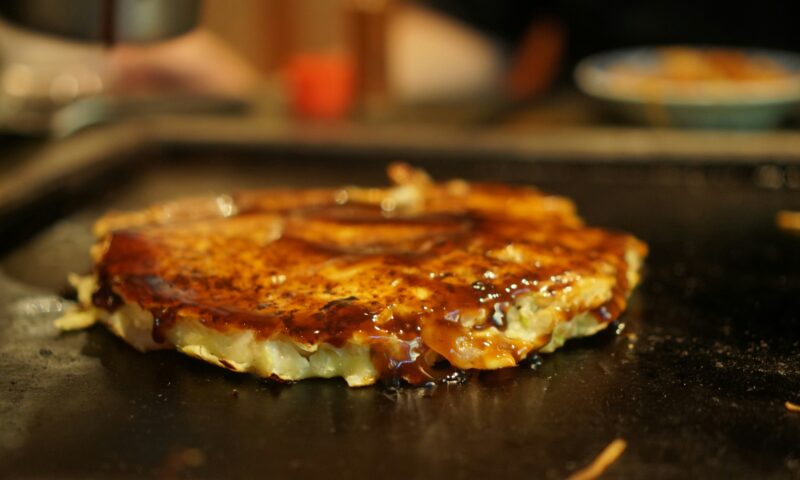
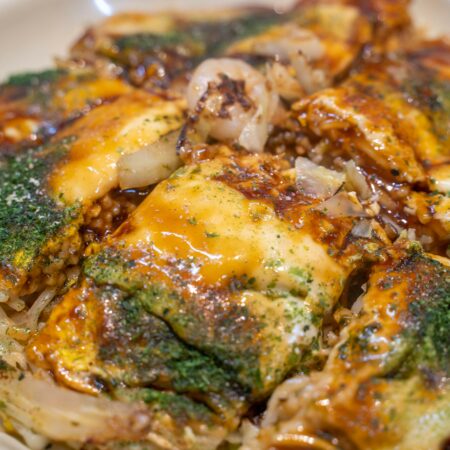
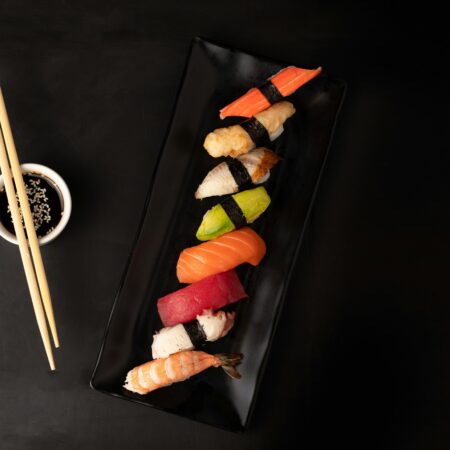

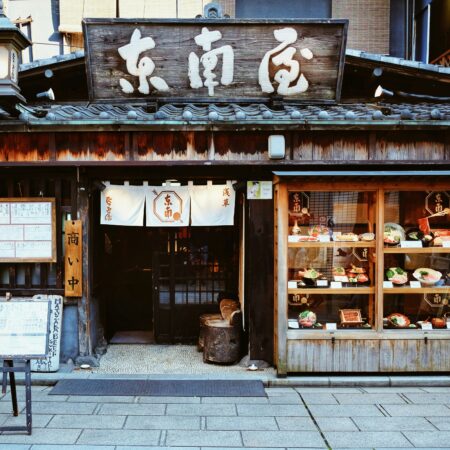
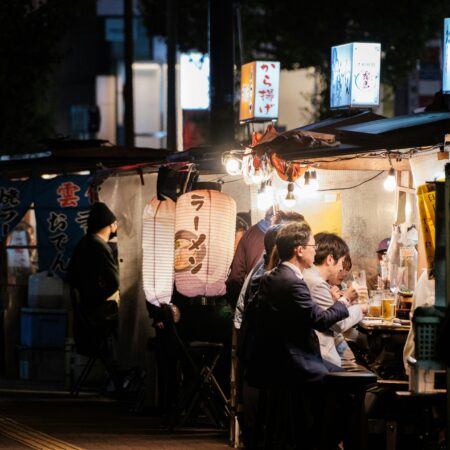
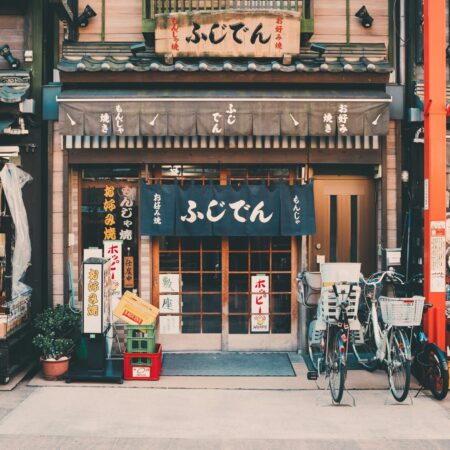
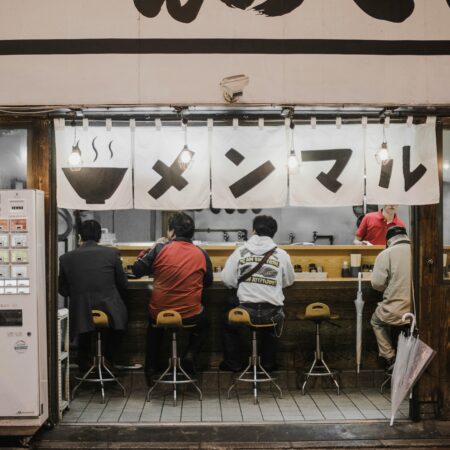

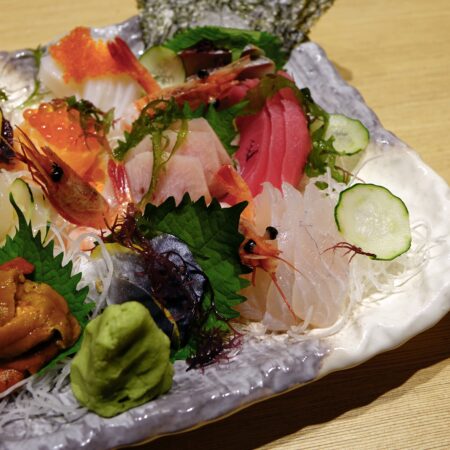
コメント